【备课参考】人教版高中英语选修6课件:Unit 4 A Global warming Workbbook(共51张PPT)
文档属性
| 名称 | 【备课参考】人教版高中英语选修6课件:Unit 4 A Global warming Workbbook(共51张PPT) | 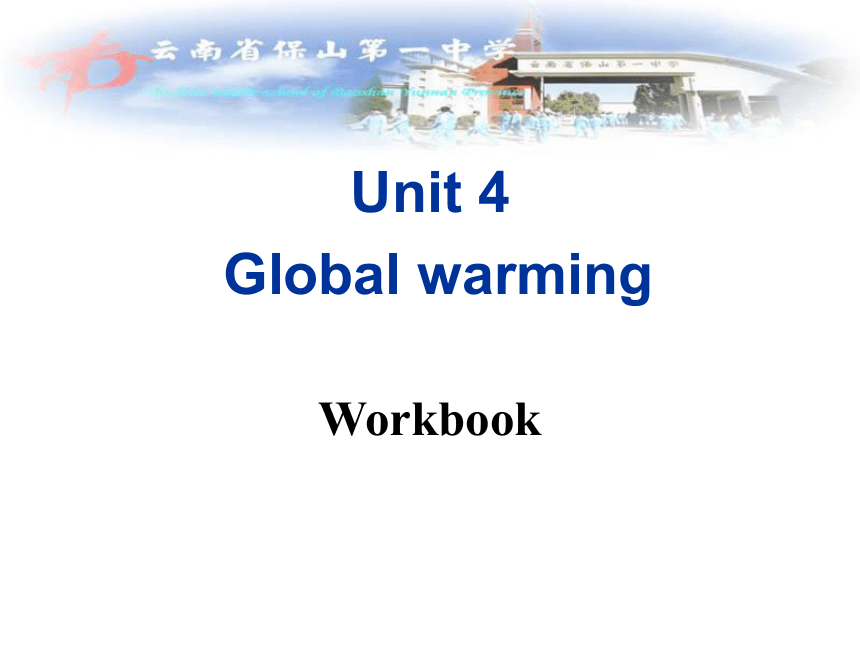 | |
| 格式 | zip | ||
| 文件大小 | 233.7KB | ||
| 资源类型 | 教案 | ||
| 版本资源 | 人教版(新课程标准) | ||
| 科目 | 英语 | ||
| 更新时间 | 2015-07-31 16:58:24 | ||
图片预览

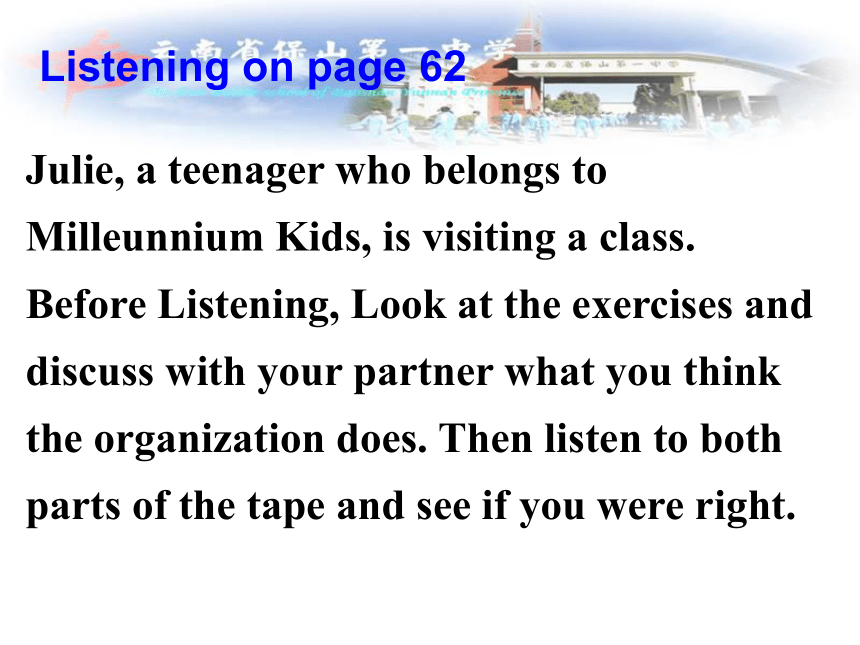
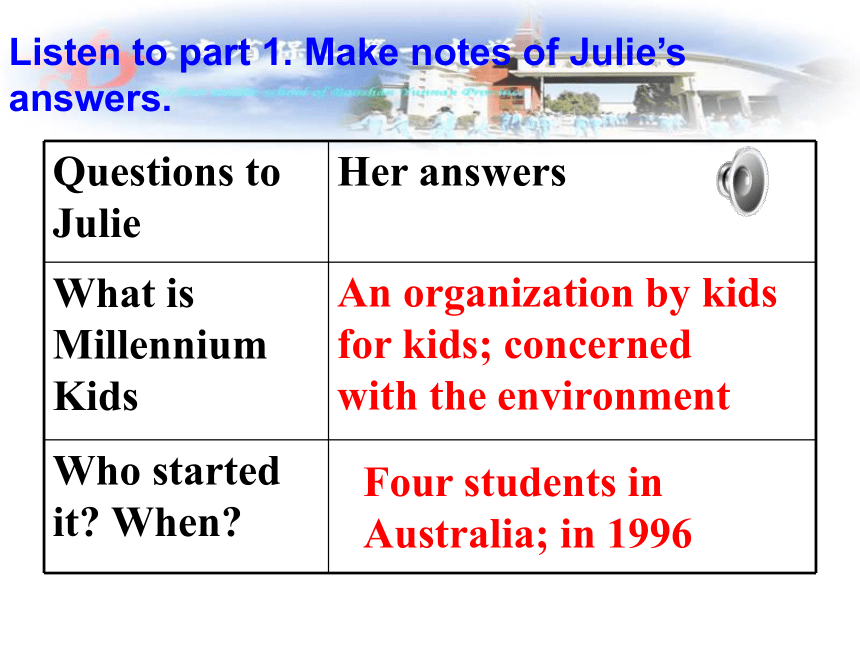
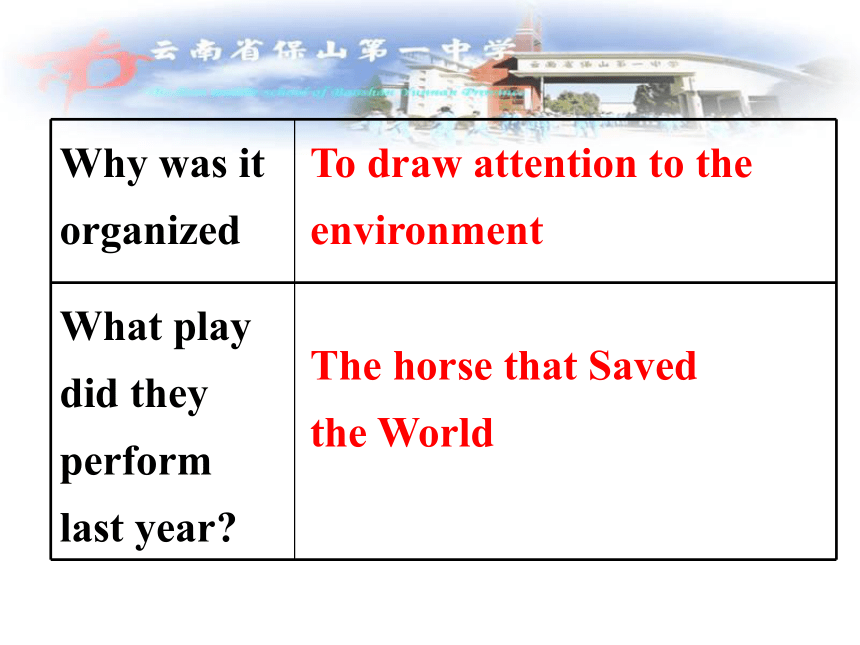
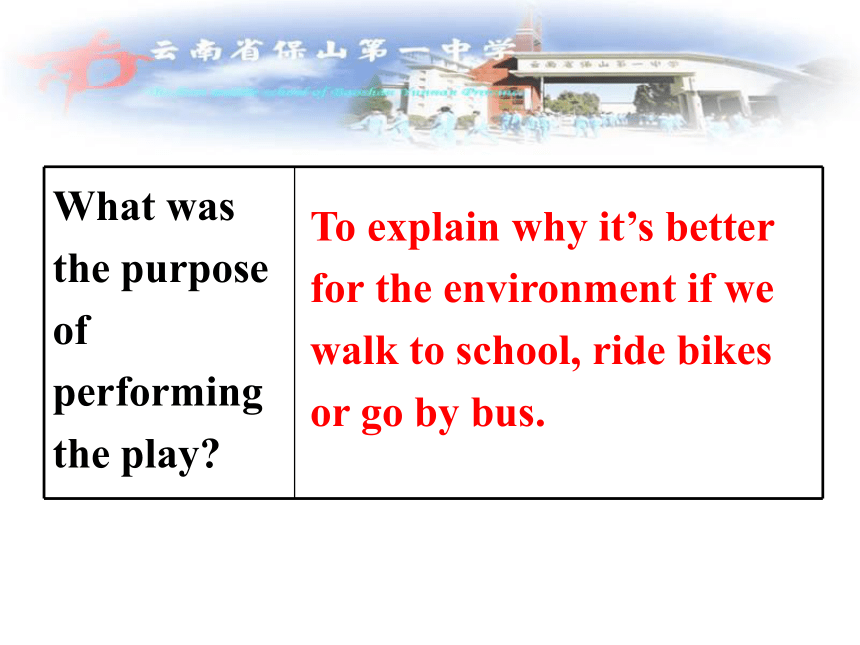
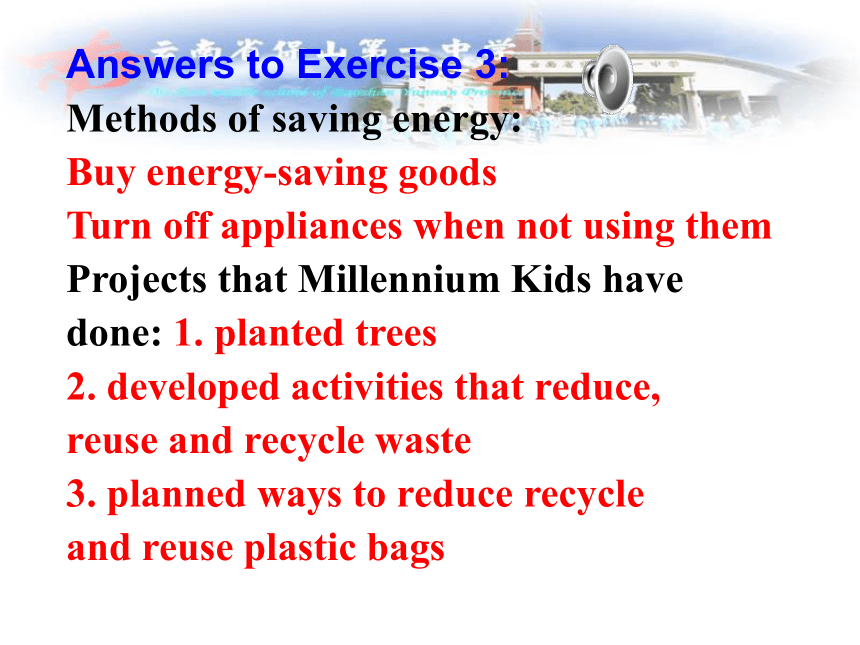
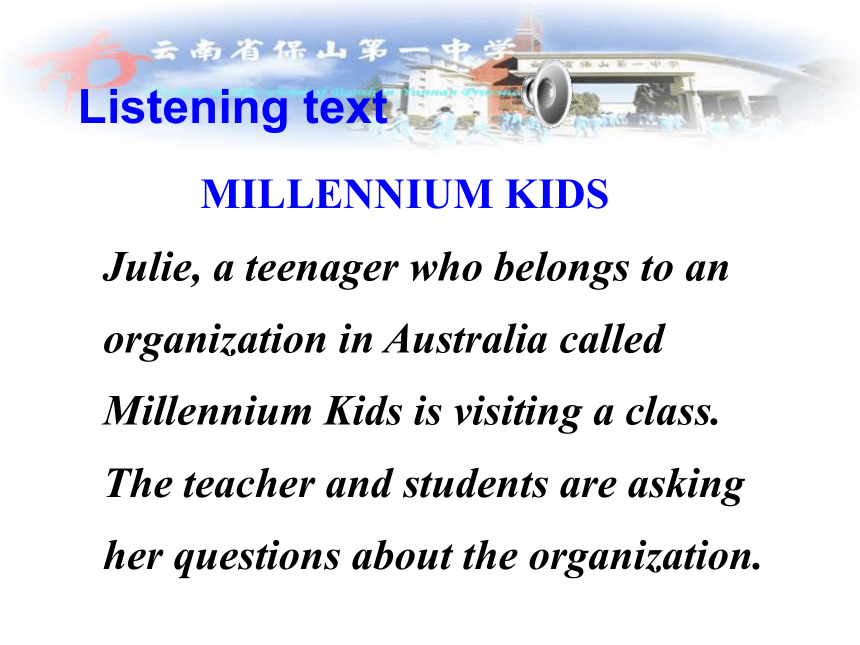
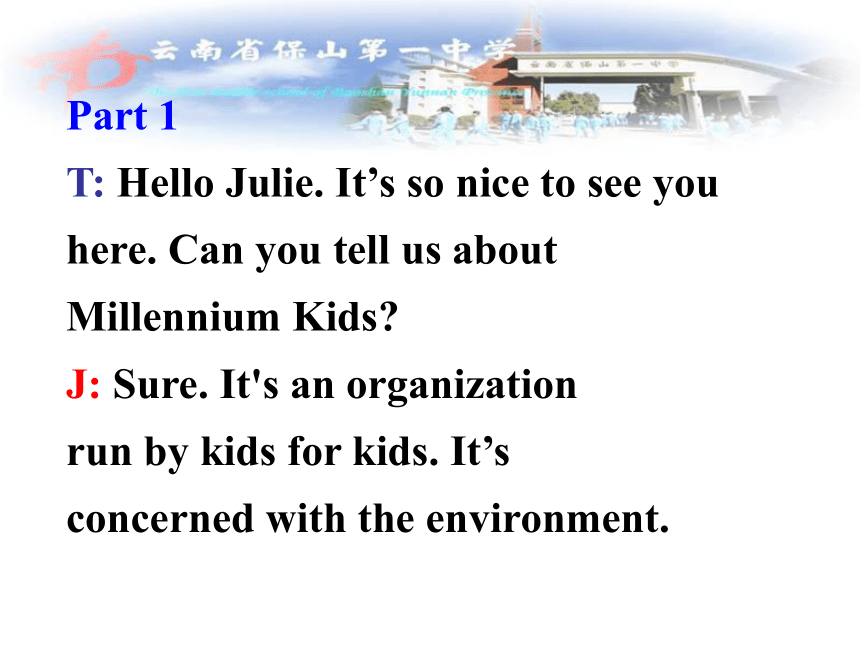
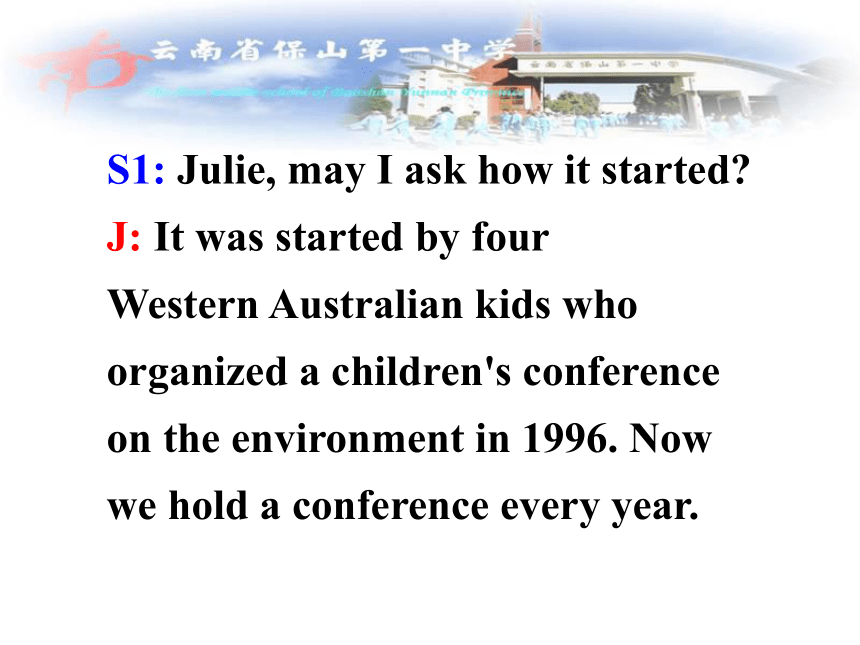
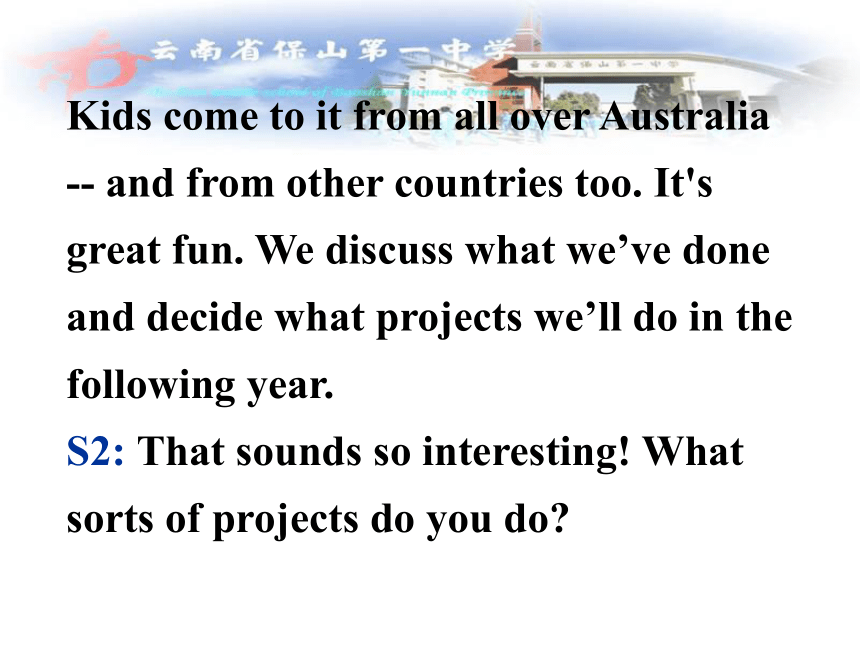
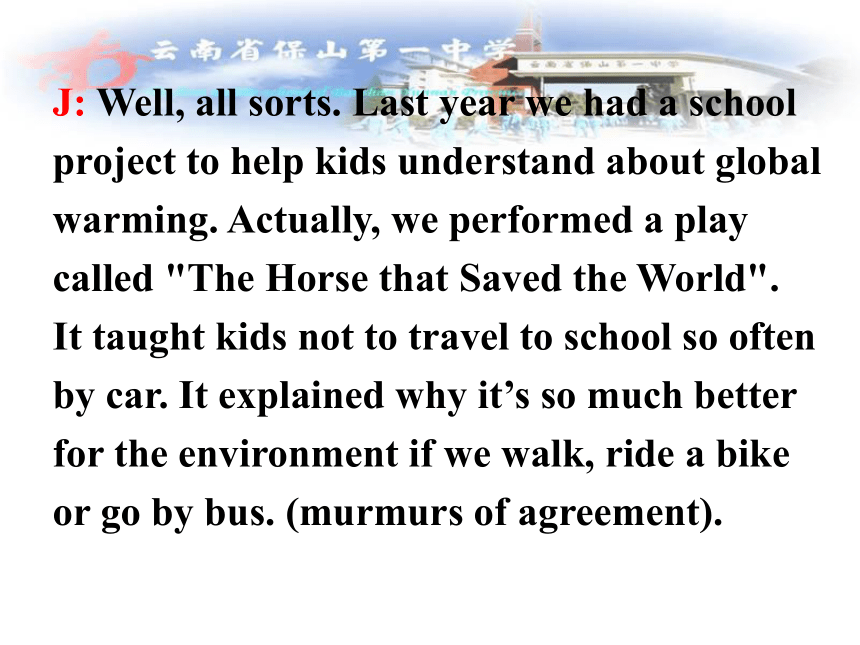
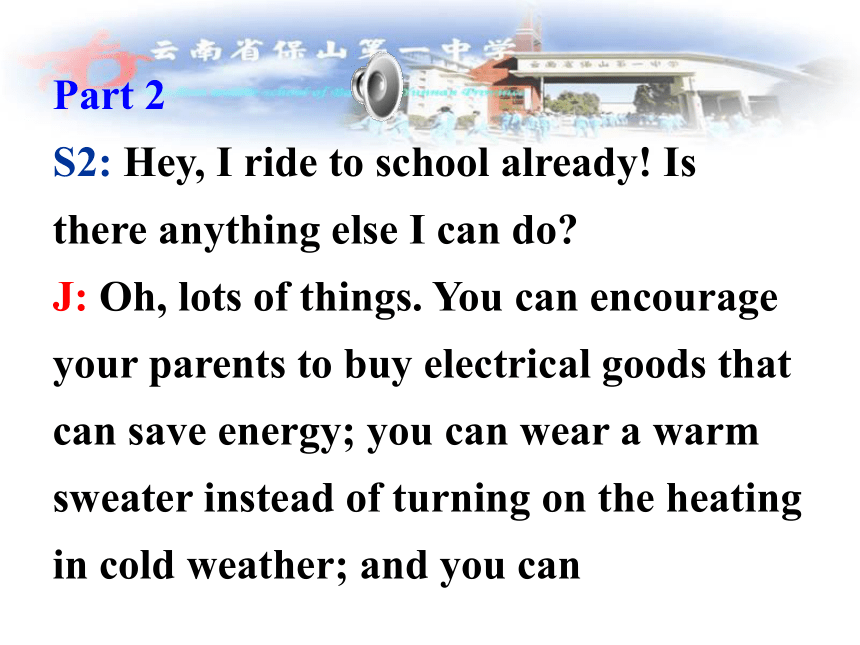
文档简介
课件51张PPT。Unit 4
Global warming
Workbook Listening on page 62Julie, a teenager who belongs to Milleunnium Kids, is visiting a class. Before Listening, Look at the exercises and discuss with your partner what you think the organization does. Then listen to both parts of the tape and see if you were right. An organization by kids for kids; concerned with the environmentFour students in Australia; in 1996Listen to part 1. Make notes of Julie’s answers. To draw attention to the environmentThe horse that Saved
the WorldTo explain why it’s better for the environment if we walk to school, ride bikes or go by bus.Answers to Exercise 3:
Methods of saving energy:
Buy energy-saving goods
Turn off appliances when not using them
Projects that Millennium Kids have
done: 1. planted trees
2. developed activities that reduce,
reuse and recycle waste
3. planned ways to reduce recycle
and reuse plastic bags MILLENNIUM KIDS
Julie, a teenager who belongs to an organization in Australia called Millennium Kids is visiting a class. The teacher and students are asking her questions about the organization.Listening textPart 1
T: Hello Julie. It’s so nice to see you
here. Can you tell us about
Millennium Kids?
J: Sure. It's an organization
run by kids for kids. It’s
concerned with the environment. S1: Julie, may I ask how it started?
J: It was started by four
Western Australian kids who
organized a children's conference
on the environment in 1996. Now
we hold a conference every year. Kids come to it from all over Australia
-- and from other countries too. It's
great fun. We discuss what we’ve done
and decide what projects we’ll do in the
following year.
S2: That sounds so interesting! What
sorts of projects do you do?J: Well, all sorts. Last year we had a school
project to help kids understand about global
warming. Actually, we performed a play
called "The Horse that Saved the World".
It taught kids not to travel to school so often
by car. It explained why it’s so much better
for the environment if we walk, ride a bike
or go by bus. (murmurs of agreement).Part 2
S2: Hey, I ride to school already! Is
there anything else I can do?
J: Oh, lots of things. You can encourage
your parents to buy electrical goods that
can save energy; you can wear a warm
sweater instead of turning on the heating
in cold weather; and you canturn off electrical appliances when you
are not using them.
S: Thanks for that. What other projects
have you done?
J: We’ve planted trees and developed
activities that reduce, reuse and recycle
waste. This year we’re asking kids to
think of ways to reduce, reuse and recycle
plastic bags– they are such a problem.S3: That sounds very interesting.
T: Well, thank you, Julie. Millennium
Kids certainly sounds like a good
organization.
J: Yes, it’s fun being a Millennium Kids.
It’s also important. If we don’t care for
the environment, we may not have a
future. That’s a pretty good reason to
do something, don’t you think? Part 1: How Ian Kierman began
Clean-up Australia Day
Part 2: Clean-up the World Day and Ian Kierman’s contribution to improving the environmentListening Task Answer key for Exercise 1 (P65)Listen to the whole talk again. Make notes in the table. 1987Ian Kierman competed in a round-the-world yacht race He was shocked at the pollution in the ocean. 1989Clean-up Day for Sydney Harbour 40, 000 volunteers; collected old car bodies, plastics,
glass bottles, cigarette butts 1990the first Clean Up Australia Day 300, 000
volunteers 2001Clean Up Australia Day most common kinds of rubbish: cigarette butts, glass bottles and plastic bags 1993the first
Clean Up
the World
Day 30 million volunteers in
80 countries 2001Clean Up the world Day 40 million volunteers
in 128 countries;
cleaned streets,
beaches, river banks
and parks CLEAN UP AUSTRALIA DAY
Tom is giving a talk to his class about
Clean Up Australia Day.
Part 1
Today I’m going to tell you about Clean
Up Australia Day. Listening textIt’s one day of the year when people in
Australia get together to clean up their
local environment. It started in 1987,
when Ian Kierman was competing in a
round-the-world yacht race. When he was shocked during the
race by the pollution he found on the
oceans. There was rubbish floating
everywhere. So when he got back to
Sydney he decided to organize a clean-
up day. He began with Sydney
Harbour. In 1989 he got 40,000 volunteers to help him clean it up. They collected tonnes of old car bodies, plastics of all kinds, glass bottles and cigarette butts.
It was so successful that Ian organized the first Clean Up Australia Day in 1990. This time more than 300,000 people offered to help and it was another success. Since then it has become a yearly event
with more and more people coming to
help. Here’s a table showing the most
common kinds of rubbish found in 2001
on Clean Up Australia Day. You can see
that the top three are cigarette butts,
glass bottles and plastic bags. We found that some of them could be
recycled. In fact Clean Up Australia
Day works so well that we now have
Business Clean Up Day and School
Clean Up Day as well. Part 2
After he started Clean Up Australia
Day, Ian moved on to Clean Up the
World Day. He got the support of the
United Nations Environmental
Programme, and as a result, Clean
Up the World Day began in 1993.
In the first year 30 million people
in 80 countries were involved.By 2001, the idea had become so popular
that 40 million people from 128 countries
took part. They cleaned streets, beaches,
river banks and parks.
I think Ian Kierman is a wonderful
man. He is an inspiration to all those who
have a commitment to solve world
problems. He makes them realize that people can
take control of a problem themselves.
They don’t have to wait for their
government to act. They can also feel
better knowing that they have
contributed to improving the
environment all round the world.
(sound of students clapping)1. the main point of view to be circled:
All sorts of items become litter, but two
of the most common and most dangerous
are cigarette butts and plastic bags. Read Tom’s essay about litter and
carry out the tasks below.Reading Task 2. The evidence about cigarette butts Tom
gives to support his argument to be
underlined:
Over 1, 600 billion cigarettes are
smoked each year in China… the toxic
chemicals add up to a great amount.3. The evidence about plastic bags Tom
gives to support his argument to be
boxed:
They are made from…
to kill another animal. 4. Tom’s solutions:
1) Put cigarette butts in the rubbish bin.
2) Not to let plastic bags become litter.
3) Use fewer plastic bags and recycle
them.
4) Not to smoke.
5) Not use plastic bags at all.Read the essay again and
make notes in the table.Litter is a serious environmental problem Cigarette butts are small but are still bad for the environment. Over 1, 600
billion cigarettes
are smoked each
year in China.
Many of the butts
become litter.2. 4.5 trillion butts are littered
every year in the world.
3. Butts spoil the beauty of the
environment
4. Butts contain toxic chemicals.
These get into the water supply.
These decrease the quality of the
water and endanger living things.
5. Butts take up to 5 years to
break down, so the toxic
chemicals add up to a great
amount.Plastic bags are
a danger to the environment. Plastic bags are made
from non-renewable
resources. If they are
not recycled, these
resources are lost to us.
2. In China, 2 billion
plastic bags are used
every day. Many of
these become litter. 3. Plastic bags last from 20 to
1000 years in the environment.
4. They can travel long distances
in the air and water. They are
in rivers, parks, beaches and
oceans.
5. Plastic bags kill up to one
million seabirds, 100, 000 sea
mammals and countless fish
each year worldwide.
6. After the animal breaks down,
the plastic bag becomes free and
can kill another animal.The environment would be less polluted if we cleaned up cigarette butts and plastic bags. The best solution would be not to smoke or use plastic bags at all.Writing Task (P67)
Writing tips:
Step 1: Write out the thesis statement.
(point of view)
Step 2: Write out the topic sentence of
the first body paragraph.
Step 3: Give the supporting points and
details about the first subtopic. Step 4: Write out the topic sentence
of the second body paragraph.
Step 5: Give the supporting points
and details about the second subtopic.
(more body paragraphs ... )Now choose a topic from the below list that you feel strongly about. Make notes on your topic using headings similar to those in the table above. Use Tom’s essay as a model to write your own.A sample list of environment topics:
air pollution, noise, soil erosion,
water pollution, litter classification, desertification, make green by
planting treesA sample version:
The Environmental Effects of
Fossil Fuels
There is no doubt that fossil fuels bring a lot of good to us. But do you know that many of the environmental problems our country faces today result from our fossil fuel dependence. The environment faces air pollution, global warming, acid rain, and several other very serious problems because of our use of fossil fuels. Over the last 150 years, burning of fossil fuels has resulted in more than 25 percent increase in carbon dioxide in our atmosphere. Carbon dioxide is one of the main factors in global warming which is negatively affecting everyone.
Fossil fuels also affect water pollution, land pollution, and thermal pollution (heat pollution). Coal mining is one of the causes of pollution in the environment. After the mining is completed, the land will remain barren. Materials other than coal are also brought to the surface in the coal mining process, and these are left as solid wastes. The production, transportation, and use of fossil fuels are to blame for the effects of pollution on the environment. Then what should we do? We should spare
no effort to improve our environment. Please save energy and use fewer fossil fuels in our daily lives.We have only
one earth!Homework:
Prepare a talk about “Clean Up China Day”.Thank You!
Global warming
Workbook Listening on page 62Julie, a teenager who belongs to Milleunnium Kids, is visiting a class. Before Listening, Look at the exercises and discuss with your partner what you think the organization does. Then listen to both parts of the tape and see if you were right. An organization by kids for kids; concerned with the environmentFour students in Australia; in 1996Listen to part 1. Make notes of Julie’s answers. To draw attention to the environmentThe horse that Saved
the WorldTo explain why it’s better for the environment if we walk to school, ride bikes or go by bus.Answers to Exercise 3:
Methods of saving energy:
Buy energy-saving goods
Turn off appliances when not using them
Projects that Millennium Kids have
done: 1. planted trees
2. developed activities that reduce,
reuse and recycle waste
3. planned ways to reduce recycle
and reuse plastic bags MILLENNIUM KIDS
Julie, a teenager who belongs to an organization in Australia called Millennium Kids is visiting a class. The teacher and students are asking her questions about the organization.Listening textPart 1
T: Hello Julie. It’s so nice to see you
here. Can you tell us about
Millennium Kids?
J: Sure. It's an organization
run by kids for kids. It’s
concerned with the environment. S1: Julie, may I ask how it started?
J: It was started by four
Western Australian kids who
organized a children's conference
on the environment in 1996. Now
we hold a conference every year. Kids come to it from all over Australia
-- and from other countries too. It's
great fun. We discuss what we’ve done
and decide what projects we’ll do in the
following year.
S2: That sounds so interesting! What
sorts of projects do you do?J: Well, all sorts. Last year we had a school
project to help kids understand about global
warming. Actually, we performed a play
called "The Horse that Saved the World".
It taught kids not to travel to school so often
by car. It explained why it’s so much better
for the environment if we walk, ride a bike
or go by bus. (murmurs of agreement).Part 2
S2: Hey, I ride to school already! Is
there anything else I can do?
J: Oh, lots of things. You can encourage
your parents to buy electrical goods that
can save energy; you can wear a warm
sweater instead of turning on the heating
in cold weather; and you canturn off electrical appliances when you
are not using them.
S: Thanks for that. What other projects
have you done?
J: We’ve planted trees and developed
activities that reduce, reuse and recycle
waste. This year we’re asking kids to
think of ways to reduce, reuse and recycle
plastic bags– they are such a problem.S3: That sounds very interesting.
T: Well, thank you, Julie. Millennium
Kids certainly sounds like a good
organization.
J: Yes, it’s fun being a Millennium Kids.
It’s also important. If we don’t care for
the environment, we may not have a
future. That’s a pretty good reason to
do something, don’t you think? Part 1: How Ian Kierman began
Clean-up Australia Day
Part 2: Clean-up the World Day and Ian Kierman’s contribution to improving the environmentListening Task Answer key for Exercise 1 (P65)Listen to the whole talk again. Make notes in the table. 1987Ian Kierman competed in a round-the-world yacht race He was shocked at the pollution in the ocean. 1989Clean-up Day for Sydney Harbour 40, 000 volunteers; collected old car bodies, plastics,
glass bottles, cigarette butts 1990the first Clean Up Australia Day 300, 000
volunteers 2001Clean Up Australia Day most common kinds of rubbish: cigarette butts, glass bottles and plastic bags 1993the first
Clean Up
the World
Day 30 million volunteers in
80 countries 2001Clean Up the world Day 40 million volunteers
in 128 countries;
cleaned streets,
beaches, river banks
and parks CLEAN UP AUSTRALIA DAY
Tom is giving a talk to his class about
Clean Up Australia Day.
Part 1
Today I’m going to tell you about Clean
Up Australia Day. Listening textIt’s one day of the year when people in
Australia get together to clean up their
local environment. It started in 1987,
when Ian Kierman was competing in a
round-the-world yacht race. When he was shocked during the
race by the pollution he found on the
oceans. There was rubbish floating
everywhere. So when he got back to
Sydney he decided to organize a clean-
up day. He began with Sydney
Harbour. In 1989 he got 40,000 volunteers to help him clean it up. They collected tonnes of old car bodies, plastics of all kinds, glass bottles and cigarette butts.
It was so successful that Ian organized the first Clean Up Australia Day in 1990. This time more than 300,000 people offered to help and it was another success. Since then it has become a yearly event
with more and more people coming to
help. Here’s a table showing the most
common kinds of rubbish found in 2001
on Clean Up Australia Day. You can see
that the top three are cigarette butts,
glass bottles and plastic bags. We found that some of them could be
recycled. In fact Clean Up Australia
Day works so well that we now have
Business Clean Up Day and School
Clean Up Day as well. Part 2
After he started Clean Up Australia
Day, Ian moved on to Clean Up the
World Day. He got the support of the
United Nations Environmental
Programme, and as a result, Clean
Up the World Day began in 1993.
In the first year 30 million people
in 80 countries were involved.By 2001, the idea had become so popular
that 40 million people from 128 countries
took part. They cleaned streets, beaches,
river banks and parks.
I think Ian Kierman is a wonderful
man. He is an inspiration to all those who
have a commitment to solve world
problems. He makes them realize that people can
take control of a problem themselves.
They don’t have to wait for their
government to act. They can also feel
better knowing that they have
contributed to improving the
environment all round the world.
(sound of students clapping)1. the main point of view to be circled:
All sorts of items become litter, but two
of the most common and most dangerous
are cigarette butts and plastic bags. Read Tom’s essay about litter and
carry out the tasks below.Reading Task 2. The evidence about cigarette butts Tom
gives to support his argument to be
underlined:
Over 1, 600 billion cigarettes are
smoked each year in China… the toxic
chemicals add up to a great amount.3. The evidence about plastic bags Tom
gives to support his argument to be
boxed:
They are made from…
to kill another animal. 4. Tom’s solutions:
1) Put cigarette butts in the rubbish bin.
2) Not to let plastic bags become litter.
3) Use fewer plastic bags and recycle
them.
4) Not to smoke.
5) Not use plastic bags at all.Read the essay again and
make notes in the table.Litter is a serious environmental problem Cigarette butts are small but are still bad for the environment. Over 1, 600
billion cigarettes
are smoked each
year in China.
Many of the butts
become litter.2. 4.5 trillion butts are littered
every year in the world.
3. Butts spoil the beauty of the
environment
4. Butts contain toxic chemicals.
These get into the water supply.
These decrease the quality of the
water and endanger living things.
5. Butts take up to 5 years to
break down, so the toxic
chemicals add up to a great
amount.Plastic bags are
a danger to the environment. Plastic bags are made
from non-renewable
resources. If they are
not recycled, these
resources are lost to us.
2. In China, 2 billion
plastic bags are used
every day. Many of
these become litter. 3. Plastic bags last from 20 to
1000 years in the environment.
4. They can travel long distances
in the air and water. They are
in rivers, parks, beaches and
oceans.
5. Plastic bags kill up to one
million seabirds, 100, 000 sea
mammals and countless fish
each year worldwide.
6. After the animal breaks down,
the plastic bag becomes free and
can kill another animal.The environment would be less polluted if we cleaned up cigarette butts and plastic bags. The best solution would be not to smoke or use plastic bags at all.Writing Task (P67)
Writing tips:
Step 1: Write out the thesis statement.
(point of view)
Step 2: Write out the topic sentence of
the first body paragraph.
Step 3: Give the supporting points and
details about the first subtopic. Step 4: Write out the topic sentence
of the second body paragraph.
Step 5: Give the supporting points
and details about the second subtopic.
(more body paragraphs ... )Now choose a topic from the below list that you feel strongly about. Make notes on your topic using headings similar to those in the table above. Use Tom’s essay as a model to write your own.A sample list of environment topics:
air pollution, noise, soil erosion,
water pollution, litter classification, desertification, make green by
planting treesA sample version:
The Environmental Effects of
Fossil Fuels
There is no doubt that fossil fuels bring a lot of good to us. But do you know that many of the environmental problems our country faces today result from our fossil fuel dependence. The environment faces air pollution, global warming, acid rain, and several other very serious problems because of our use of fossil fuels. Over the last 150 years, burning of fossil fuels has resulted in more than 25 percent increase in carbon dioxide in our atmosphere. Carbon dioxide is one of the main factors in global warming which is negatively affecting everyone.
Fossil fuels also affect water pollution, land pollution, and thermal pollution (heat pollution). Coal mining is one of the causes of pollution in the environment. After the mining is completed, the land will remain barren. Materials other than coal are also brought to the surface in the coal mining process, and these are left as solid wastes. The production, transportation, and use of fossil fuels are to blame for the effects of pollution on the environment. Then what should we do? We should spare
no effort to improve our environment. Please save energy and use fewer fossil fuels in our daily lives.We have only
one earth!Homework:
Prepare a talk about “Clean Up China Day”.Thank You!
